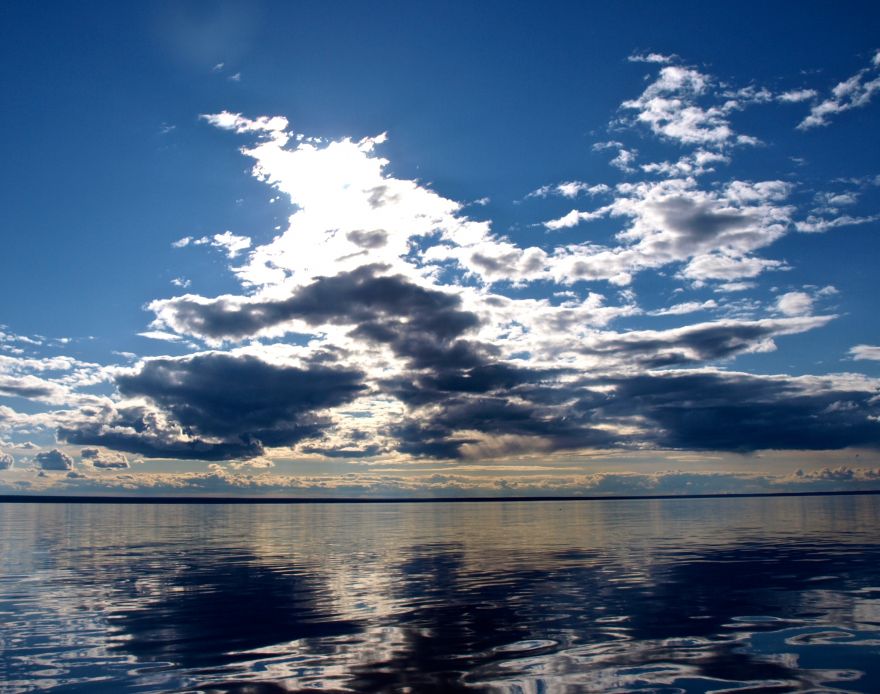In the Beginning it Was Just Too Long! - Trophy Lodge, July 16 to 26, 2010
![]() Written by
Harold
Written by
Harold
- Published in Trip Journals
- Read 4121 times
- font size decrease font size increase font size
This year’s trip started off with a bang as I walked up to the Air Canada check-in counter in Toronto in preparation to boarding my flight to Edmonton.
Under the mistaken impression that because I was flying Business Class I might expect a polite greeting and a hassle free check in, the “Customer Service” agent took no time at all to shatter my expectations, because the first thing out of her mouth was “that’s too long!”
I was going to take it as a compliment at first until I saw that she was pointing at my rod tube.
I politely pointed out that over the past thirty years I have been flying Air Canada on my way to Great Bear Lake it has never been “too long.”
The past being of no concern to her, she informed me that it was not her fault that no one had ever chosen to enforce the “too long” rule for all those years, so if I wanted to take my fishing rods along with me this time around it was going to cost $75.
Rather than get into an argument – a rational discussion was highly unlikely – I paid the “Customer Service” agent and eventually boarded my flight.
We had a short stop over in Edmonton where Ken Gold, Art Ross and I hooked up with Rodney Harback and Kevin from Harriman, Tennessee before boarding our Westjet flight to Yellowknife.
It was almost déjà vu all over again as the say when the Westjet Customer Service agent pointed at my rod tube and sadly said, “I think that may be too long.”
After explaining that I was having difficulty in understanding why the same fishing rods I had been taking north with me for more years than I care to remember were suddenly too long, she smiled and said “Oh, I didn’t know they were fishing rods, not a problem and there won’t be any additional charge.”
Take note Air Canada.
The “Diamond” of the North
Upon arriving in Yellowknife we picked up our rental car and then checked into the Explorer Inn. We then embarked on a tour of both the “old” and “new” parts of town, and conducted what turned out to be futile search for UV milk, which as you may recall from last years journal, is an essential ingredient when making Hush Puppies.
Either there were lots of people planning on making hush puppies or UV milk was just extremely popular, because none was to be found in any of the five stores we visited. We ended up buying some UV Soya milk; so stay tuned and I will let you know how the hush puppies turned out using this somewhat unique ingredient.
Yellowknife, which is located on the shore of Great Slave Lake, is the capital city of the Northwest Territories and boasts a population of about 18,700.
Once famous for its gold mines, Yellowknife is now the diamond center of Canada and acts as a base for servicing several operating diamond mines further north.
It features both the old and the new as the Wildcat Café in “Old Town” and the Wal-Mart in the new section will attest to.
They have one of the most eclectic aviation centers that you are likely to find anywhere in the world. All manner of World War 2 vintage planes such as the DC 3 and DC 4 are still in service or sitting idle waiting to be broken down for parts.
Bush planes of every size and description, Hercules transports, firefighting and various STOL aircraft are everywhere to be seen.
While Yellowknife is a modern city in most respects, and as such has many of the modern day amenities that you would expect, the one thing it does not appear to have is a sewer system, nor do the houses appear to have in ground septic systems.
I suspect the reason for this is that the city is built on solid rock, and the cost to install these types of systems, even assuming it would be possible, would be prohibitive.
We got some first hand experience regarding their sanitary system when a truck with a large round tank mounted on it backed up to a house, and in doing so blocked the road so we could not get by.
They guy driving the truck hooked up a hose to a pipe of some sort, and when he opened the valve, the stench that enveloped our vehicle had all of us gagging.
Rolling up the windows and blasting the air conditioning did not help, and we could not escape by backing up as there were several cars lined up behind us.
As we came to realize, people, at least in that part of town, had above ground sewage holding tanks, and I would imagine that you could make a pretty good living if you were in the holding tank drainage business – once you got used to the smell that is.
Not letting the mere smell of raw sewage deter us, we eventually returned to the hotel and had a very good meal in their dinning room.
I enjoyed some delicious grilled Muskox tenderloin, and if you ever have the opportunity to try some, I would highly recommend it.
Day 1 – Three’s a Charm
Rather than fly from Yellowknife to the main lodge, this year we flew directly from Yellowknife to Trophy aboard an Air Tindi Dash 7.
It had been several years since we flew directly onto the strip at Trophy, so it was going to be interesting to see what kind of shape it was in.
The strip is one of the few flat pieces of land you will find in that part of the world and the only way you know for certain you are approaching the landing area is that the grass and wildflowers are a bit shorter on the strip than off to each side.
I sincerely hoped the pilot could make out the difference.
We landed without any problem at all, in fact the Dash 7 was made for landings of just this kind, and after walking down the hill from the strip to the dock area, a small flotilla of guides and their boats were waiting to ferry us over to the lodge.
While we would be heading across the lake to the Katseyedie River to set up camp the next day, today our objective was to pay a visit to the Whitefish River and get reacquainted with the pike that are usually found there in large numbers.
Trophy did not operate in 2009, which meant that no one had fished the area since 2008, so we were hoping the pike would be bigger, hungry and otherwise glad to see us.
The weather was perfect with sun and light winds, so after rigging up we wasted no time in getting underway.
We were only about two miles from the lodge when the motor suddenly lost power and all but shut down. All Kenny and I could think of was the time several years ago when we found ourselves marooned on shore in much the same area as a result of a wonky motor.
After letting the motor cool, we managed to limp back to camp at half throttle. Ernie the camp mechanic took at quick look, and after changing the thermostat, pronounced us good to go.
This time we managed to get about two and one half miles from the lodge when the motor began billowing white smoke and then quit. We just stared at one another for several minutes with no one saying a word.
It certainly appeared that the Fishing God’s had concluded that pike fishing was not to be on our agenda.
Yet again we managed to limp back to camp, and after a brief inspection, Ernie declared the motor unfit for further service and bolted on a new one that he assured us would cause no further grief.
We held our collective breaths as we sped by the “furthest west” we had achieved so far that day, and finally made it to the Whitefish without further incident. Like I said, threes a charm.
After all of that the damn pike had better be in a cooperative mood – and they certainly were. We fished the weed lines on both sides of the channel leading into to the river mouth and the fish were everywhere.
The weeds were higher than we had ever seen them, which was not surprising in that the ice had left the lake very early this year. It was like fishing in the 4th or 5th week of the season rather than the 2nd. The lake trout had also taken notes, and as we were to find out later, they had moved out of the shallows into deeper water.
Overall we caught between sixty and seventy pike in four hours of fishing with the biggest being Kenny’s twenty pounder. While there were also a number of fish in the high teens, the majority were in the five to ten pound range - every one of them hungry and mean.
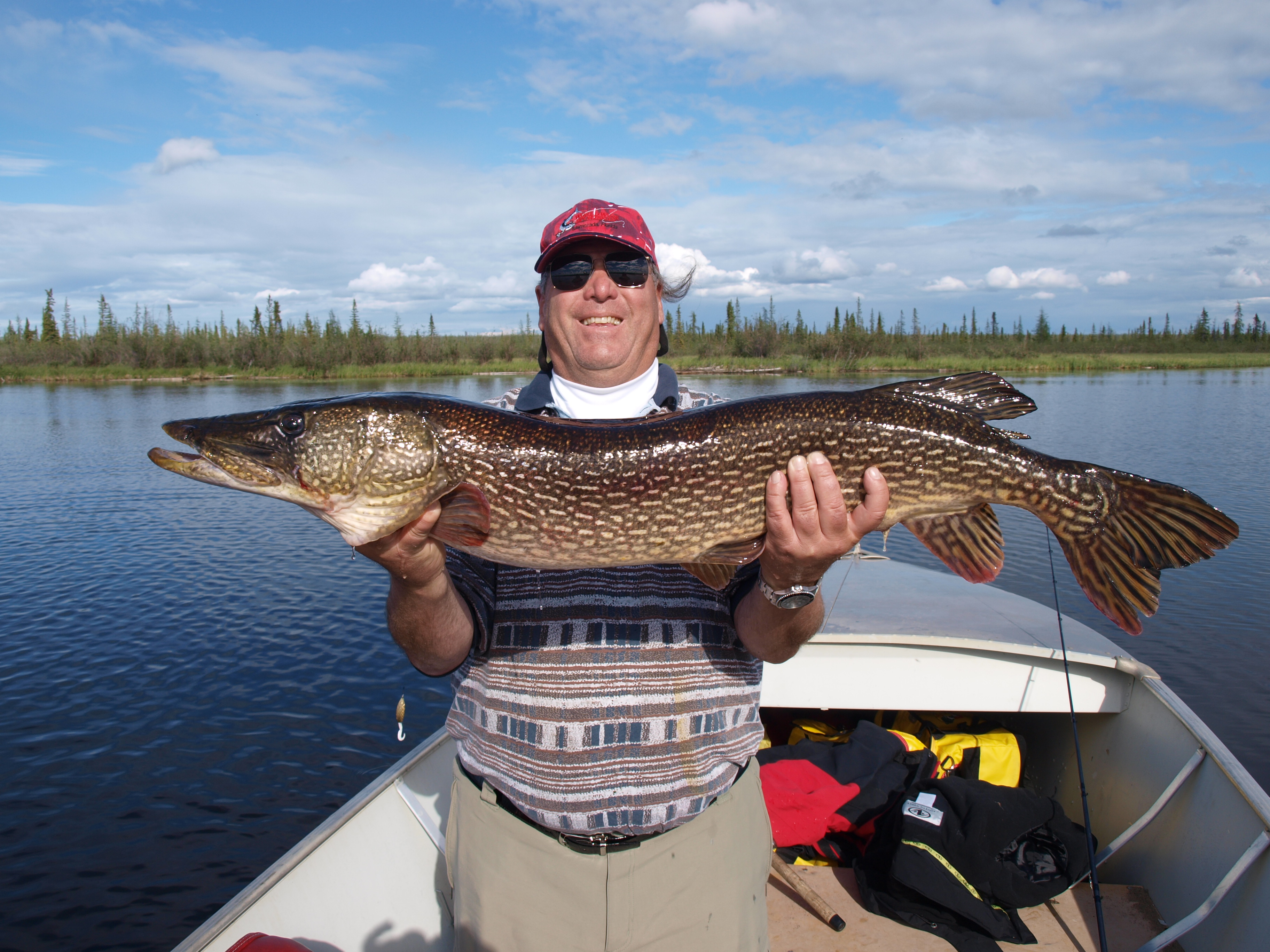
The area was rich with water birds, and we saw good size flocks of Red Throated Loons, Skoaders and Old Squaw Ducks.
On the way back to the lodge Kenny summed up the day perfectly when he said:
“If heaven is like this, then that’s where I want to be.”
I suggested that it was going to take a lot more work on his part if he really expected to receive an invitation upstairs someday.
Day 2 – Tripod Revisited
As planned the guides headed out for the Katseyedie at 6:30 the following morning. If the traveling conditions were good the trip should take them between three and four hours. We followed in the turbo Otter and met up at the old Branson’s Lodge outpost location around 11 am.
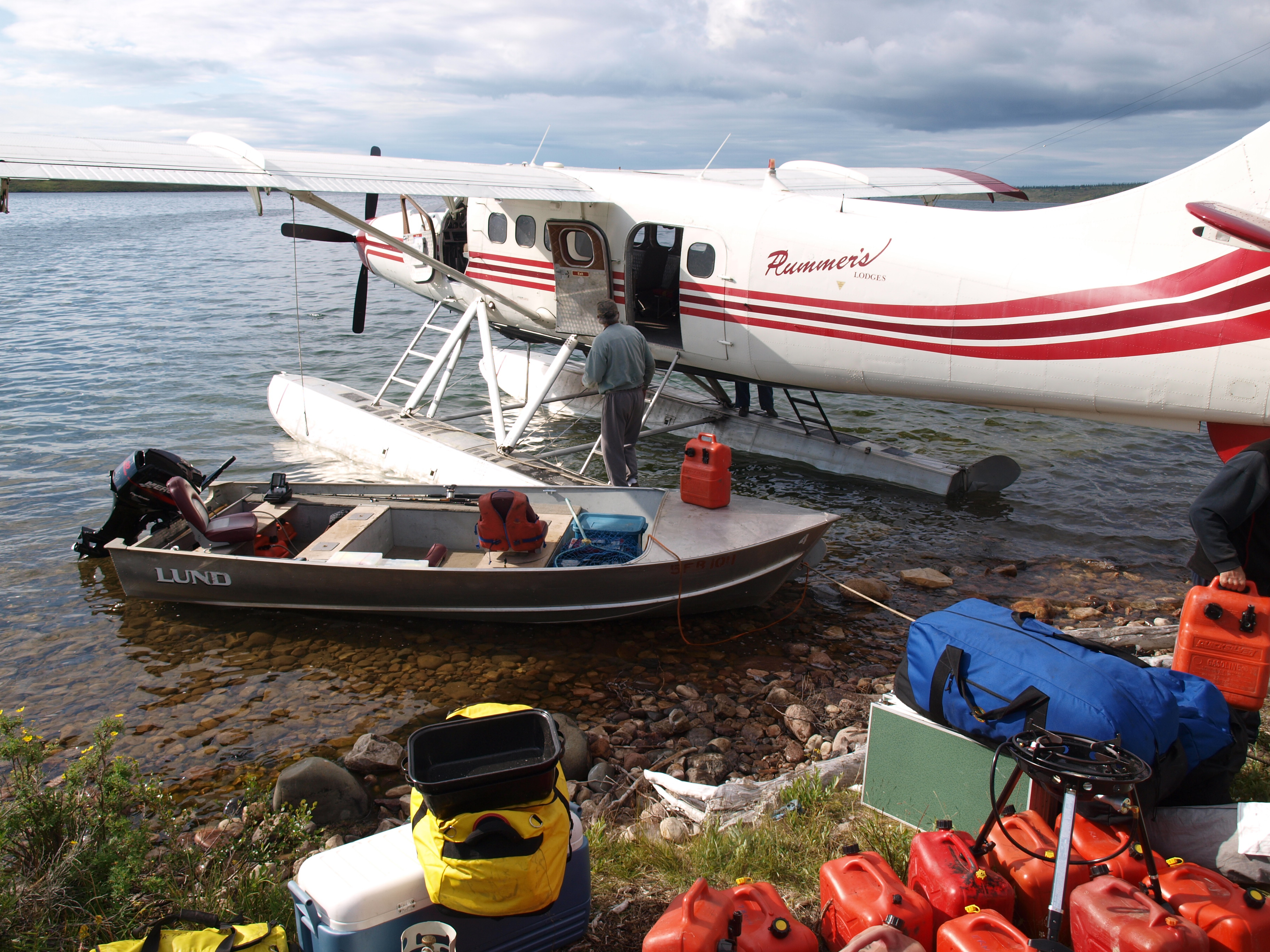
The bugs were certainly waiting for us, and after spending two hours setting up camp, we all headed off to fish Tripod Point, one of our traditional early season hot spots.
The trip over was a bit bumpy, but overall not too bad. Upon arrival I spotted a herd of about thirty Muskoxen on the ridge just east of the point but was unable to get close enough to get any good pictures.
I suggested that we should pull up on shore so I could climb the ridge and take a few shots, but my suggestion did not receive a very enthusiastic response – so you are just going to have to take my word for it.
We did the majority of our fishing slightly east and west of the point in five to twelve feet of water. The water, which is usually crystal clear, was a milky color because the wind had stirred up the sandy bottom.
The water temperature was between fifty and fifty-two degrees, which is about perfect for lakers, and we did catch forty fish. My biggest was fifteen pounds, but Kenny led the way with a 20 and 28 pounder. Overall the five of us caught just over 100 fish.
The lure of choice was “old faithful,” a chartreuse T60 flatfish with black and red dots, because this particular colour usually does well in stained or silty water. I lost the only two I had that afternoon, so if that colour remained hot, I would have to borrow, beg or steal another.
After a fairly smooth ride we arrived back in camp about 7 pm. It was dead calm that evening and the entire bay was alive with fish.
There were so many Grayling and small trout rising after floating insects it looked like rain drops dimpling the surface of the lake. Kevin and I grabbed some light tackle, tied on a couple of small spinners and began catching a fish on virtually every cast.
Day 3 - There’s No Place Like “Omen”
Our day began sunny and warm with barely a breath of wind, and remained so for the balance of the day.
Fish by the thousands were fining throughout the bay and there were at least fifty loons, both Common and Red Throated enjoying the excellent fishing.
As we were preparing to head out, two juvenile Bald Eagles treated us to a close formation fly over. Once underway a large Golden Eagle cut across our bow, which I have been told is considered to be a good omen, and that really pumped us up in anticipation of the day to come.
Given the conditions, we decided to make the twenty-mile trip across the arm to Goodfellow Point. Goodfellow frames the eastern most extremity of MacIntosh Bay, and is also the site of a mass grave where it’s said that twelve souls were buried following the sinking of a schooner in the 1930’s.
We decided to begin fishing outside of the bay because the water temperatures were ideal being in the high forties and low fifties.
We fished between five and twenty feet, but other than several small fish there was not much doing. Two boats went inside the bay to the “3 rivers” area, but the water was far too warm, and I believe they didn’t catch a single fish.
Kenny, Ryan and I decided to head back over to Tripod Point while the others went east to try their luck at Ekka Island.
It was beginning to appear that notwithstanding the optimum water temperatures in the shallows, the fish must have moved into deeper water.
We stopped at Ikanyo Island so Ryan could use the “facilities,” and came across some great structure surrounding the island, but with the water temperatures in the low forties, we decided to keep moving on.
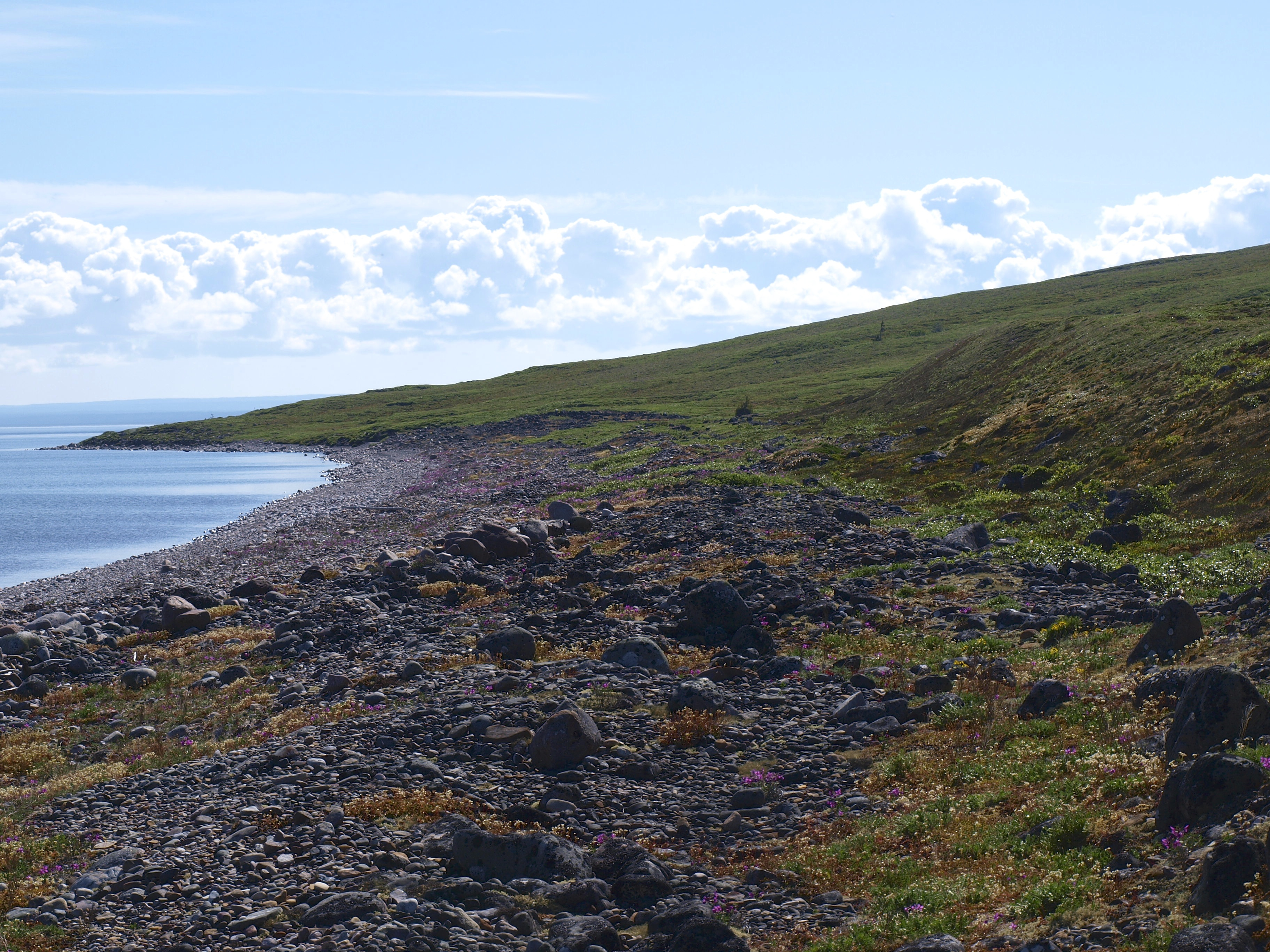
Given our luck, or more particularly our lack thereof, we decided to fish some deeper water, and once we arrived at Tripod we moved well off shore and began trolling in fifty feet of water. Ryan marked a few fish but they were not interested in what we had to offer.
We moved into the shallows where the fish had been the previous day, but only managed to come up with several small fish. The good news was, one of them volunteered to join us for lunch.
We had an excellent shore lunch that featured Ryan’s special cornflake and dill trout.
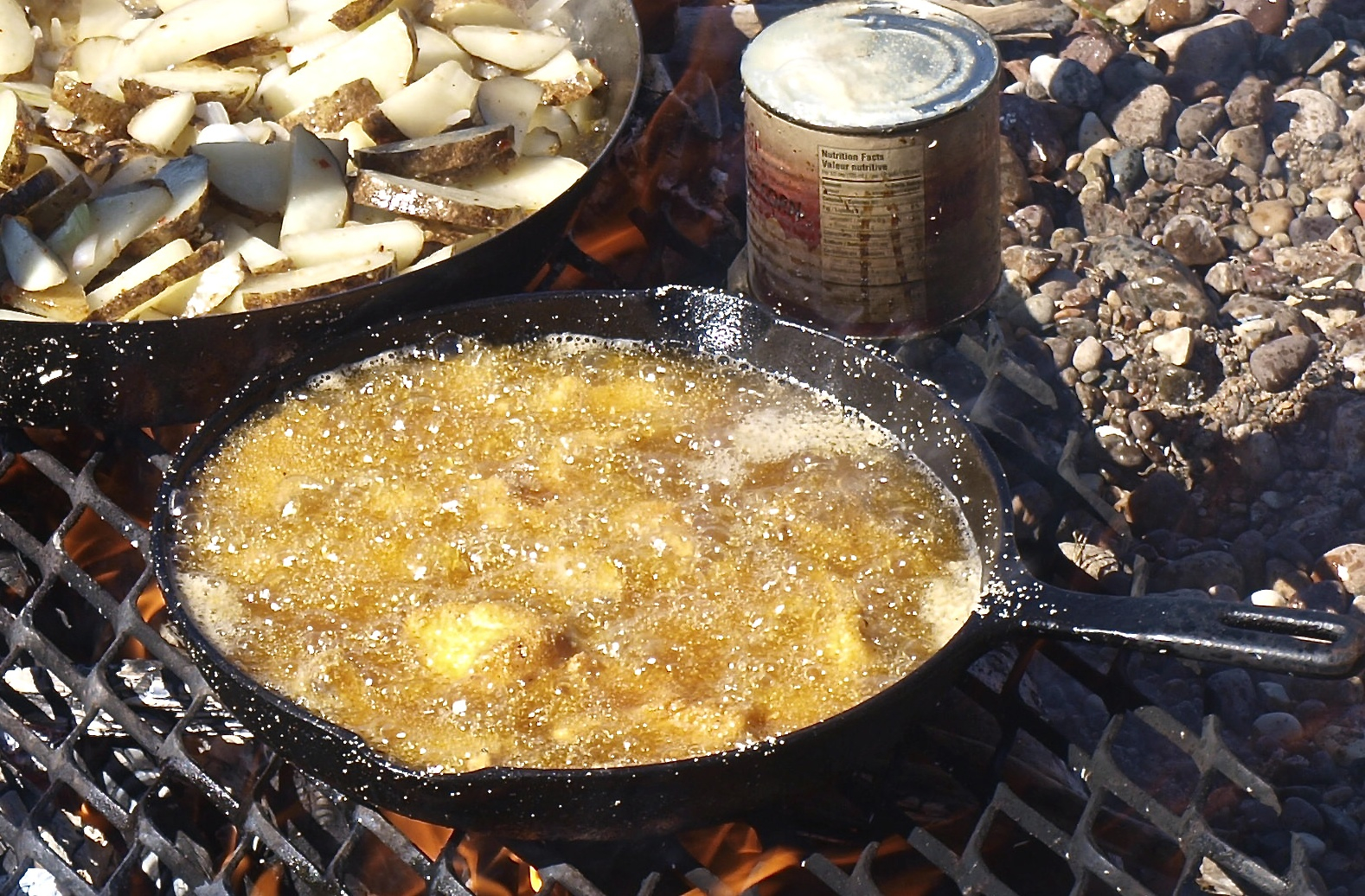
I climbed the ridge while lunch preparations were underway hoping to get a glimpse of the Muskoxen that we had seen the previous day. While they were nowhere to be seen, the land was otherwise exploding with life.
Brilliant wild flowers were in bloom everywhere, terns and sandpipers were tending their nests, a ptarmigan and her young exploded out of a clump of willows as I walked past, and a Grizzly had recently been busy digging a hole about the size of a Buick in an attempt to get its paws on some of the ground squirrels or “sic sic’s” that abound in the area.
There was a bumper crop of deer or “Bulldog” flies this year, and while eating my lunch I watched 100s of them emerge from the water and onto rocks to dry their wings prior to commencing their reign of terror on unsuspecting animals and fishermen alike.
Spring and summer is very short in the Arctic, therefore the plant, animal, bird and insect life must “make hay” while the sun shines for that ever so brief period.
On our way back to camp we stopped to fish the bay on the east side of the channel that leads into the Katseyedie. Starting about fifty yards from shore, the water goes from 250 feet to two feet in that short space.
We saw and caught a number of small trout, primarily very tight to shore and came across the dock that used to be at the old outpost washed up on shore. Although the ice and wind had moved it over two miles, it was still in good shape considering what it had been through.
The guys did not catch any big fish at Ekka, but they had a similar experience with the deer flies.
It remained calm throughout the evening, and the Grayling and Lake Trout put on another magnificent display as they fed on the millions of insects covering the surface of the water.
Day 4 – Goose Me
The weather had changed over night, and we now had overcast skies and relatively cool temperatures.
Art, Rodney and Kevin decided to make the ninety minute run to McGill Bay, while Kenny and I stuck closer to camp and fished along the west side of Kroger Island.
The water temperatures were optimum being within the forty-nine to fifty-two degree range, but other than several small fish, the big ones were nowhere to be found in the ten to twenty feet of water we were fishing.
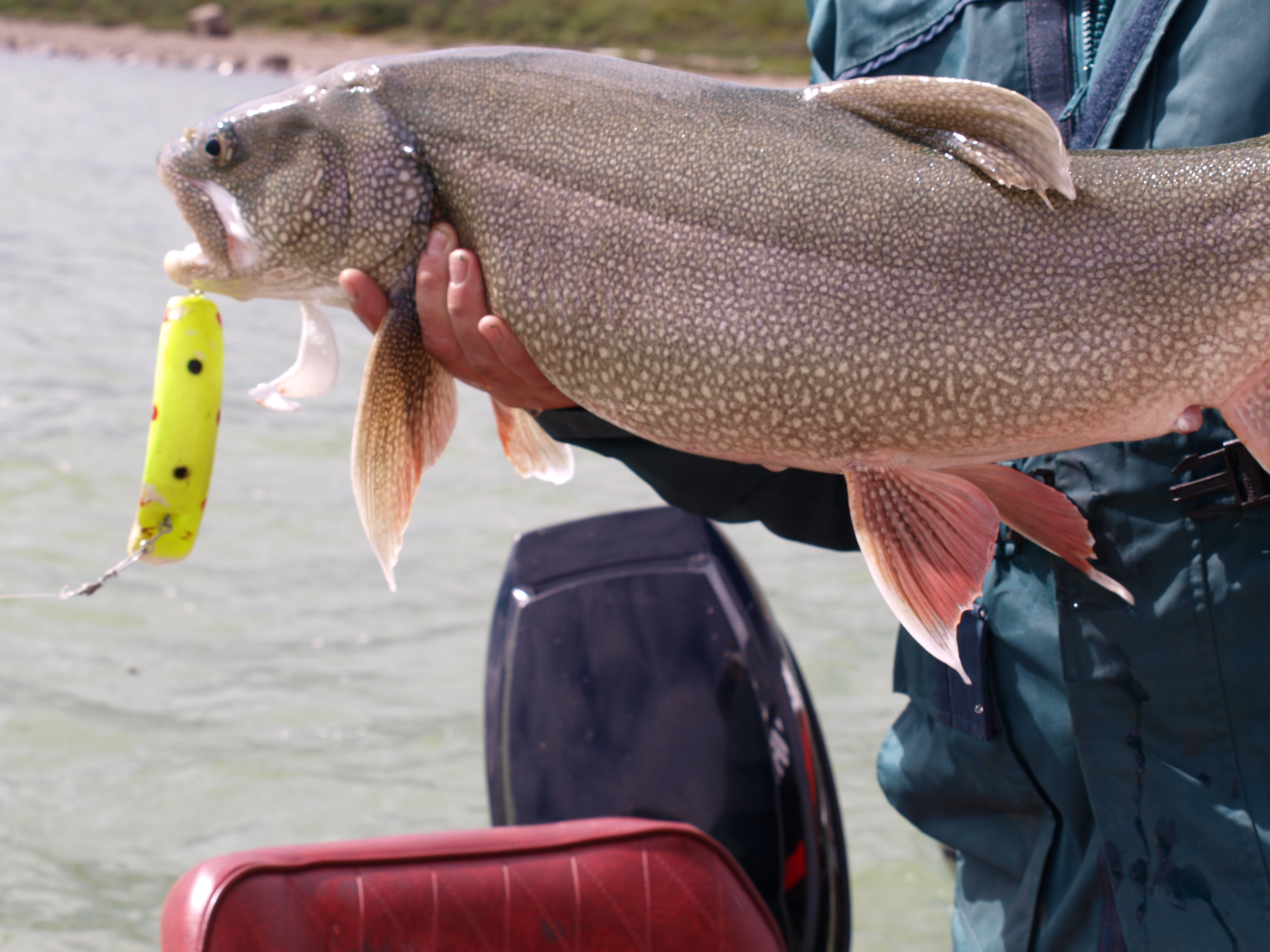
When visiting Great Bear it’s always a good idea to be alive to your surroundings because you never know what might see. In this case while trolling along the shoreline of Kroger I spotted four large birds that looked vaguely familiar.
As we moved closer I could clearly see they were Canada Geese. While they wouldn’t warrant a second glance back home, I have never seen a Canada goose at Great Bear in any of my previous visits.
After giving Kroger a good play, Ryan suggested that we slowly work our way back to camp. We were due to be picked up in about six hours and we had yet to break camp, therefore we did not want to go too far a field.
Our first stop was in the narrows that lead to the short portage into Power Lake. The area is made up of large sand flat that dropped off to sixty feet in the middle of the narrows. We could see large numbers of small trout swimming around, but nothing of any size.
There was a consensus that this area would be well worth a visit just after ice out.
We noticed another small bay just before the portage accessible through a second set of narrows, but to get in for a look see, we had to pull the boat along the shore because of the shallow sandbar blocking the entrance.
We saw a few small fish but didn’t stay long as the water temperature was just over sixty degrees. This small bay was over sixty feet deep in places, and would also be worth a visit right after ice out.
Our next stop was in home bay because we wanted to fish the large sand bar just west of the outpost cabin. I had caught a forty pounder off that sand bar several years ago, and we were hoping that history would repeat itself. We fished along the edge of the bar where it tapers off into deep water and caught two eighteen pounders.
The other guys soon turned up, and while they caught a few fish off of the shoal just outside of McGill Bay, there was nothing over twenty pounds.
We then got down to the business of breaking camp, and the Otter turned up at 4 pm and flew us back to the lodge. The guides had a fairly smooth trip and were back at the lodge before 9 pm.
On balance it was a very good camping trip. Because the weather cooperated we were able to hit every “big fish” location on our list.
While every one of these places has produced big numbers of huge fish for us in the past, and notwithstanding what appeared to be optimum water temperatures, they obviously had moved out of the shallows into deeper water, and were now going to be much more difficult to find.
Day 5 – The Laughter of Children
Today we were going to take the ninety-minute ride east to the Naiju River. The fishing around the Naiju is much like dipping into a box of assorted chocolates – every piece (or in our case every cast) produces a surprise when you bite into it.
If you choose to fish tight to shore there are plenty of small Lake Trout and trophy size Grayling. The river mouth attracts schools of large Whitefish, and if you venture into the river there is excellent Pike fishing.
To top things off if you fish a bit deeper along the shoreline both east and west of the river mouth, you stand a reasonable chance of tying into a trophy Lake Trout.
It’s also a fantastic place for a shore lunch. There is usually a herd of Muskoxen in the area, and its not uncommon to see some caribou.
You have the option of fishing right from shore while lunch is cooking for trout, Grayling and Pike, and for the history buffs you can climb to the top of the esker just west of the river mouth, and visit the grave of the Sahtu Dene medicine man, old Karkeye himself.
Our day started off with overcast skies, and while the sun came out just after breakfast, unfortunately so did the wind. By the time we arrived there were three-foot waves to contend with.
This made fishing tight to shore a challenge, but we did manage to catch a couple of shore lunch fish and one impressive three and one half pound Grayling, all on a small white jig.
Several Dene families who had made the 100-mile plus trip from Deline occupied our usual shore lunch spot. They had set up a rather impressive camp, and were busy building a new crib for their medicine man’s grave, and given the number of rifles we saw in camp it was obvious that they planned to do some hunting as well.
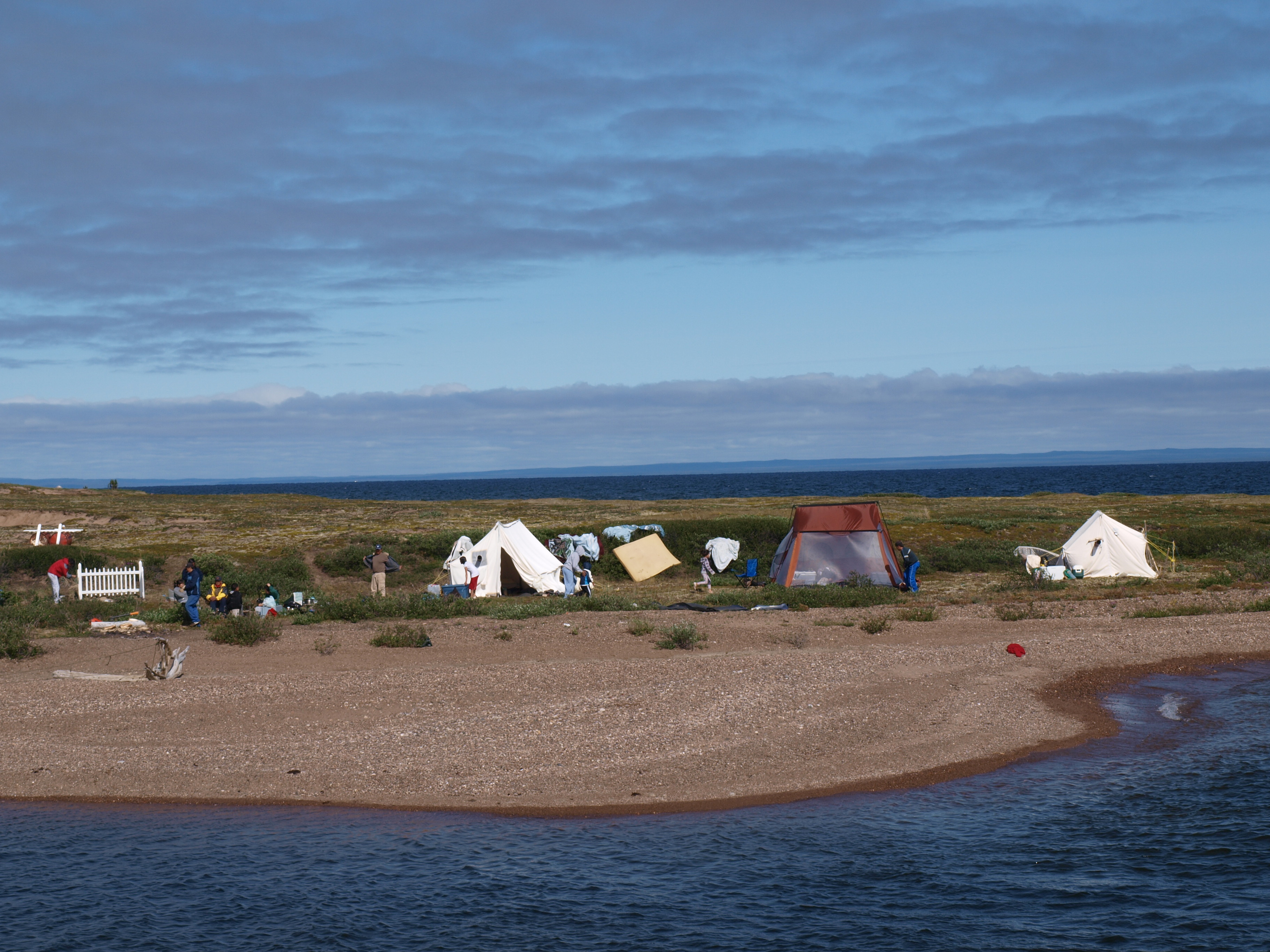
Before stopping for lunch, Kenny and I moved just inside of the river and caught twelve Pike with the biggest being just over twelve pounds.
As it turned out all three of our boats had a lunch fish to contribute, meaning that the eight of us were going to have to dispose of twenty-three pounds of fish!
Our lunch consisted of:
• Cajun fried trout
• Blackened Trout
• Baked trout with stewed tomatoes, lemon pepper and dill
• Fried potatoes and onions
• Hush Puppies (the Soya milk was fine)
• Beans
• Corn
• Dad’s Oatmeal Cookies
• Campfire coffee
We enjoyed our lunch listening to the children laugh as they splashed in the water and played games with their parents – it was an amazing experience.
One thing I really got a kick out of was that both groups were busy taking pictures of one another while waving and smiling across the river, each of us no doubt thinking that once we got back to our respective homes we could tell our friends about the interesting people we met and show them the pictures.
The wind was still kicking up a fuss so we all decided to move into the river and try our luck for some Pike. I switched over to my fly rod and tied on a red and black streamer while Kenny stuck with hard wear using a blue and silver Fox, Vibrex Spinner.
While the spinner slightly out fished the fly in terms of numbers, I caught the biggest Pike at sixteen pounds.
We fished just inside the mouth again, picked up several fish and then moved about 200-300 yards into the river and began working a mid-river weed bed.
It was literally crawling with fish, and at one point Kenny caught ten fish on twelve consecutive casts. Moving deeper and deeper into the river we hit fish on virtually every bend and visible weed bed.
We had traveled about a mile and one half upstream were we ran into Rodney and Kevin, who were parked in the middle of a rather large weed bed. By the grin on each of their faces it was obvious that they were doing very well.
Kenny and I boated over 100 Pike and Rodney and Kevin caught at least half as many as that again. Art, who was so full of fish after lunch, stayed on shore and had a long nap while we tended to the Pike.
While the wind had not abated all that much, it was still a pretty good ride back and Ryan handled the boat beautifully.
It was a great day in every respect.
Day 6 – Lands Forlorn
The wind stayed up for most of the night and was still blowing come morning, but because it was out of the North/East, “Home” bay was relatively calm.
Rather than fish deep for trout, Kenny and I decided to concentrate on Grayling. We fished along the East shore in the quietest water we could find.
The Grayling were plentiful and we caught about thirty, a number of which were in the three-pound range. Every so often a small trout would join in on the fun, so it did not take very long to secure a lunch fish.
Our other two boats spent the morning fishing what is known as the “gap” and caught several small trout, although Rodney did manage to come up with a 23 pounder.
We lunched in the same area where Kenny and I had been fishing for Grayling, and as always we had an excellent meal. Together with the usual fixin’s consisting of beans, corn, fried potatoes with onions and Dad’s Oatmeal cookies, we enjoyed trout fried in a lemon/garlic coating, and grilled trout with herbs and garlic.
Two juvenile Bald Eagles and one adult decided to join us for lunch, so we were sure to leave the fish carcasses in plain sight where they could easily get at them.
After swallowing our lunch, followed by our pride, Kenny and I decided to move out onto “Airport Reef” and fish heavy metal in deep water. My heavy metal consisted of a Husky Devel in a Fire Tiger colour pattern, and Kenny tied on a three-ounce inline sinker together with a T60 Flatfish.
We fished for close to three hours between 30 and 70 feet and didn’t get a single hit. Maybe it was just because we dislike fishing deep water so intensely that our hearts were not in it that made the difference – who knows?
All I do know is, that other than one previous occasion several years back where I did pretty well on Airport, our luck has usually been bad.
When fishing deep water, don’t expect numbers, but what you do catch will usually be over twenty pounds. The best way I can describe it is long stretches of absolute boredom, followed by several minutes of shear terror.
The good news was, Art Ross who has pitched more shutouts on Airport than anyone we know, did catch one small trout. On the way into the lodge we made one pass through the “gap” and Kenny came up with one small trout.
After dinner we were treated to a slide show and narrative by guide Chris Brekke, who along with three other adventurers traveled from the Dease Arm on Great Bear Lake to Kugluktuk, or Coppermine, as it was once known where the Kugluktuk River empties into the Arctic Ocean at the Coronation Gulf.
They followed the identical route taken by mining engineer George M Douglas in 1911 on his journey to the Kugluktuk River. He published the account of his journey in a book entitled Lands Forlorn.
Chris and his crew traveled over 580 miles in a span of nineteen days, using only Douglas’ book as their guide. They even went so far as to name their canoes after George’s, the Polaris and the Procyon.
It’s said that things change very slowly in the arctic, and their journey was certainly evidence of that. They took great pains to mirror the photographs Douglas took of various landmarks and sections of the Dease River and amazingly, even some of the tree branches over hanging the river had not moved in the past ninety-eight years.
They had numerous encounters with the local wildlife, including being stalked by a Barren Ground Grizzly for some considerable distance along the Dease River, and numerous sightings of Caribou and Muskoxen.
One of their more interesting finds was coming across large numbers of Grayling concentrated in several small ponds, that were spread along the ten kilometer portage between the Dease River and the Dismal Lakes.
Chris described the entire experience as traveling through an Arctic oasis.
Later that evening, three guests who had been out camping for five days returned to the lodge.
While we did not run into them, they visited many of the same places we had – with similar luck. They fished both shallow and deep, and while they caught all the small fish they could handle, their only trophies were a 41 pounder caught in fifteen feet of water just off Goodfellow Point, and a 28 on the sand flats north of Kroger.
It was comforting to know we weren’t the only ones!
Day 7 – The “Little Houses” on the Whitefish River
We had rain, lightning and thunder throughout the night and it was still storming during breakfast. Things finally cleared up enough to travel safely around 9:30, so Ryan and I headed out. Kenny, who had not been feeling well, decided to stay in, as did Rodney, Art and Kevin.
A light rain was falling as we pulled away from the dock, so we thought it best to fish locally and keep an eye on the weather.
Abandoning any shreds of pride we had remaining, Ryan and I headed over to Airport Reef given its relative proximity to the lodge. I tied on my Fire Tiger Husky Devel, and to make sure it was at or near bottom, added a three-ounce in-line sinker. Ryan went with a long thin mother of pearl spoon, and four ounces of weight.
We fished for three hours in thirty-five to sixty feet of water, and other than one fish Ryan had on for a heartbeat, there was no other action. I hate that reef.
The weather cleared, so rather than continue to wash lures, we headed over to the Whitefish River to see if the Pike were in a more cooperative mood. I also wanted to travel some distance up stream to see if the fishing was as good deep in the river as it was around the mouth.
We fished the river channel leading into the mouth for a few minutes, and found out in the hurry that the fish were still there in abundance. Heading deeper into the river we stopped to fish a weed bed where a small stream entered the river on the west side and caught several fish, most of them small, but two of them were in the mid teens.
We continued to fish our way up stream, but other than the weed bed off that small stream, we did not pick up any more fish.
After traveling over two miles up river we came across three trappers cabins. We stopped to take a look around, and surprisingly two of the cabins had pad locks on the door.
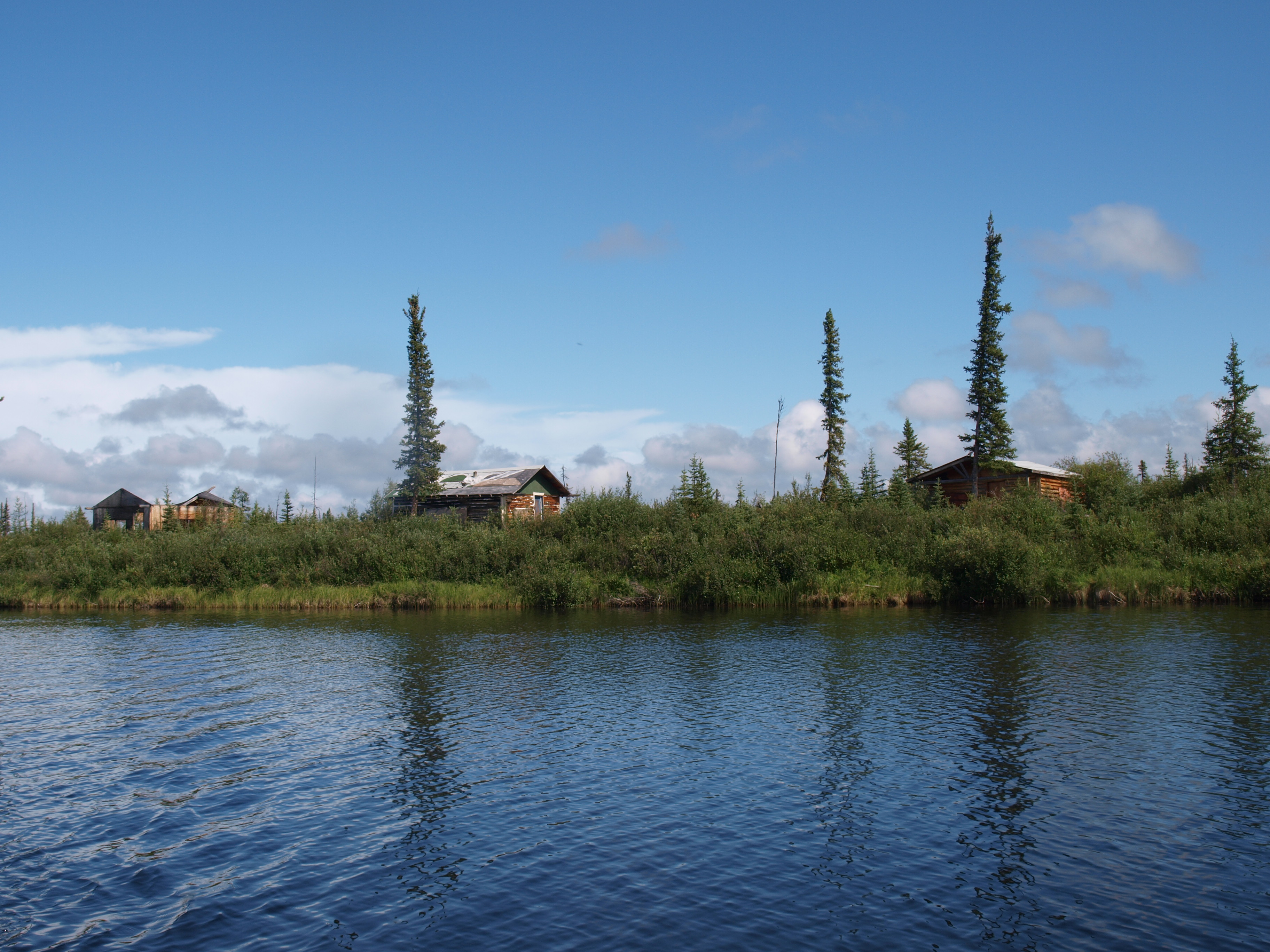
It’s rather unusual to lock cabins, especially in so remote a location, but the trappers’ security system did require some reengineering because the back window on both cabins was missing – so if anyone really wanted the rusty old lanterns and bed springs that had been left behind - they would find them easy pickings.
We had a leisurely ride back to the mouth of the river and surprised both a Tundra Swan and a Red Throated Loon along the way.
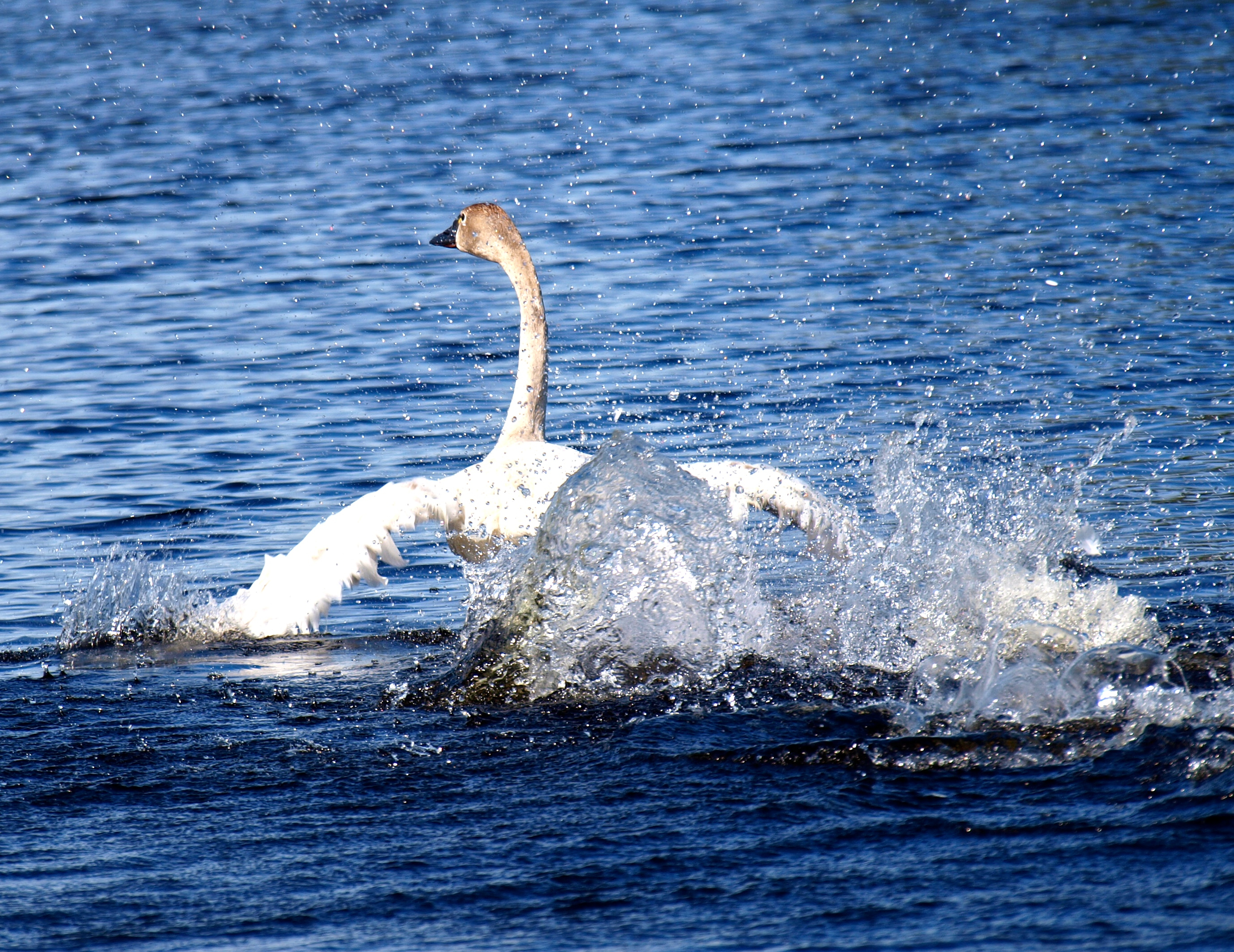
I am used to the haunting and not unpleased cries of the Common Loon, and I was certainly surprised when the Red Throated member of the loon family expressed its displeasure at Ryan and I for invading its space.
If you have ever heard a bearing blow out on an outboard motor, which is a high pitched whine followed by a sickening clunk, then you now know exactly what a Red Throated Loon sounds like.
On our way up river we noticed a noticed stream entering the river on the East side, and agreed we would stop for a few casts on the way out. It was one of the smarter things we that day, because on his first cast Ryan caught a beautiful twenty pounder.
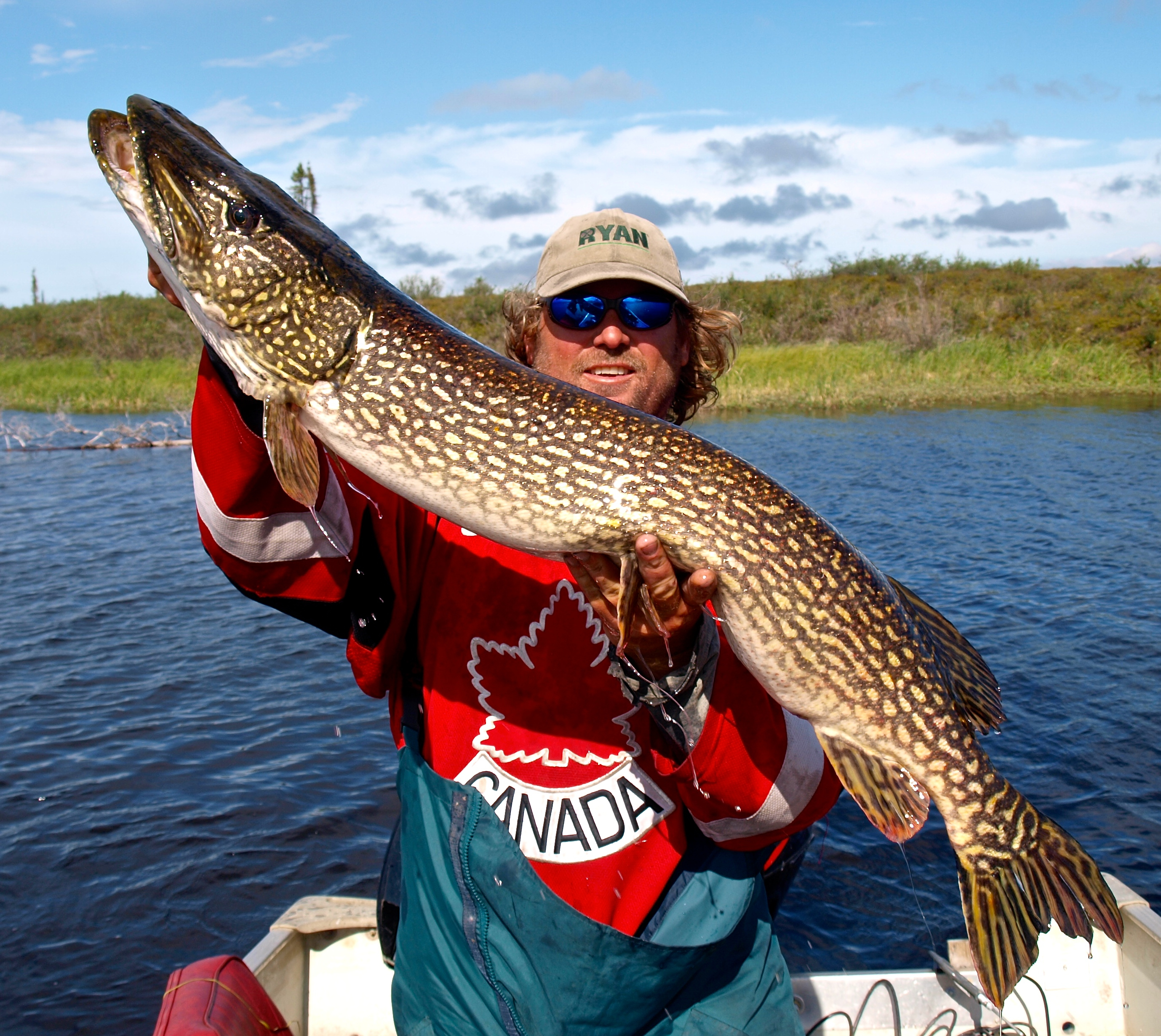
The lesson learned was that if you go upstream beyond the point where the first two steams enter the river, don’t expect to catch many Pike.
Being gluttons for punishment we made one last stop at Airport in the faint hope that one of us could fluke a big fish. Ryan was literally on fire as he got one hit and one small trout in the two hours we spend criss crossing the reef. As for me, I pitched yet another shutout and was now starting to close in on Art’s record.
The group of dentists we had been sharing the lodge with throughout the week had headed east to fish the “X” shoals, and using patience, perseverance, two small portable downriggers, several coolers of beer, ten pounds of weight, and most importantly a positive attitude, had a very good day.
These guys usually come up much later in the season, and are used to, and obviously don’t mind fishing deep. They had managed to pull in a few big fish earlier in the week, primarily off of Airport.
Two of them used massive fly rods, and tied on heavy weights and T60 Flatfish so they could fish them deep. It certainly paid off, although I suspect that it would take a considerable amount of time to bring in a large fish on a fly rod – regardless of how heavy it was – and that would not bode well for these Lake Trout’s chances of survival after being released.
One fortunate guy caught four fish between 20 and 49 pounds, all in a span of two hours. As a matter of fact, four other big fish were caught within the same period. It just goes to show that if you are in the right place when the dinner bell rings, chances are you will do well.
While we had a very good day, the best was yet to come.
Around 10:30 that evening as we were kicking back in the lounge going over the events of the past week, I saw my daughter Christine hop out of a plane that had arrived with the groceries for the incoming group.
I was not expecting to see her, because we did not stop off at the main lodge, where she was working, on the way in. They decided to bring her over to help out as Trophy was going to be at capacity the following week.
While her primary job was to look after the bar/tackle shop, she wound up doing pretty much everything that needed doing, including the baking.
While I have been at Trophy when well over 100 big fish had been caught throughout the week, this weeks totals were not all that bad considering the fish had moved into deep water.
In my experience your best chance to catch large numbers of big fish is early season, right after ice out, when they are clustered in the shallows.
When they move out of the shallows and into deeper water, the fish scatter and you have to cover a much larger area to find them. The “X” shoals, which is great late season spot, covers an area exceeding 100 square miles, so don’t expect the action to be fast and furious throughout the day.
That said, when you do tie into some fish, and you will if you are prepared to put the time in, it will likely be well worth the wait.
The “hog log” had thirty-six entries comprised of Lake Trout weighing:
41, 28, 23, 28, 32, 25, 27, 27, 42, 20, 20, 25, 20, 32, 20, 35, 20, 22, 25, 35, 33, 36, 27, 26, 28, 35, 41, 44, 25, 43, 48, 35, 42, 20, 39 and the big fish of the week, 49 pounds.
Throw in two 20 Pike for a grand total of 38 or 1158 pounds of fish. For the fishing statisticians among you the average size per fish was 31 ½ pounds.
Not too shabby, particularly if you include the hundreds, if not thousands of fish weighing less than 20 pounds that were caught, but not recorded.
In keeping with Plummers’ conservation policy, all thirty-eight fish were released.
Southward Bound – Tripus interuptus
The plan, ah yes, the plan. Our plan to get home was a masterpiece in many ways, but as we all know, while having a great plan is all well and good, at the end of the day it all comes down to execution.
Our plan was to be picked up at noon, have a very short layover in Yellowknife, catch our flight to Edmonton and arrive in time to go out for dinner. We would then overnight in Edmonton, catch our flight to Toronto early the next morning and be home by early afternoon.
Now that was just the plan for Art, Kenny and I. Rodney and Kevin’s plan became more complicated once they left Edmonton on Sunday morning, because they had several connections to make before they would finally touch down in Tennessee.
And then there were the dentists. Some were heading back to Toronto, others to California, some to North Carolina and all points in between.
As you can see there were many, many plans, all of which went into the tank once our Air Tindi Dash 7 sprung a hydraulic leak just before takeoff in Yellowknife.
While normally that would have only resulted in a delay of about one hour, in this case that extra hour did us in. Why? Because the Yellowknife air show started around noon and they closed the air space from 11:30 to 3:30, with the result that we did not get picked up until 5.
There were no other flights out of Yellowknife to Edmonton after 5 so every one of us missed our connections, and to top things off, there was nothing out of Yellowknife until 3 the next afternoon, so anyone who had a morning or early afternoon flight out of Edmonton had to scrub that as well.
One enterprising chap made a couple of calls form the lodge to see if we could book a charter from Yellowknife to Edmonton Saturday evening, and he did find one air service who could accommodate us. The price to fly fifteen of us to Edmonton in a Dash 8 was $31,000. You do the math.
One very helpful Air Canada ticket agent and $700 per person later, Art, Kenny and I got a flight out of Yellowknife late Sunday afternoon and a connecting flight to Toronto that would get us home around midnight. Rodney would not know what he was dealing with in terms of getting back to Tennessee until we arrived in Edmonton.
Well, it is what it is. Rather than mope around we ventured out and grabbed some dinner and a cold beer in Yellowknife on Saturday evening and visited the Prince of Wales Heritage Centre and Museum the following morning.
So as not to leave you with the impression that everything went smoothly from that point forward, let me fill you in on some of the other challenges that fate tossed our way.
Upon arrival at our hotel in Yellowknife all the computers were down, so they were unable to check us in. No worries, we would go out for dinner and check in later.
We decided to head over to the Black Knight pub, which we were told, had best burgers in the Northwest Territories.
I advised the hostess that we were five hungry souls in search of some food and was summarily informed that the pub was closed for a private charity event.
No problem, we would just head back to the hotel and have dinner there, because after all we knew the food was good at the Explorer. As I approached the hostess, and before I could say, “Table for five,” she informed me the dinning room was closed.
By this time it was just after 9pm and we were beginning to worry that most places would be closing up soon. Asking the desk clerk for some help, she told us to head over to Boston Pizza because they were open until mid night.
We grabbed a cab, got seated and began scanning the menu. Rodney was first up and as he started to order our waitress stopped him in mid sentence, and said all they had available was pizza and a few pasta dishes. Ribs, burgers, chicken – forget it.
I ventured to ask why, and was told that the power had been off throughout Yellowknife for most of the day, so they had to move the majority of their food to another location where generator powered refrigeration was available.
Guess what we had for dinner??
Hell, pizza washed down with a couple of cold beers after a day like this was no too bad after all.
Epilogue
If you have read any of my other journal entries you will have come to realize that there is never a dull moment or any “same old – same old” on any of these trips, and 2010 was no exception.
While we caught very few trophies, there was no shortage of fish, great shore lunches and fellowship.
The weather was perfect for the most part, allowing us to hit all the places where, in other years we had caught some remarkable fish. There is a reason why they call it fishing and not catching, and even on Great Bear you have to take your lumps from time to time.
When it was all said and done, to quote “Honest” Ed Mirvish, a famous Toronto retailer, restaurateur, and impresario:
“There ain’t no place like this place any place!”

